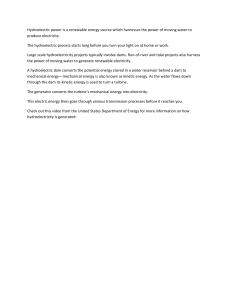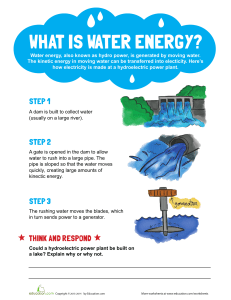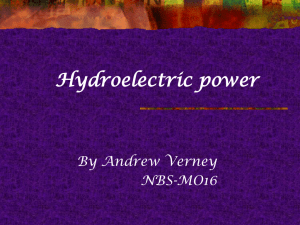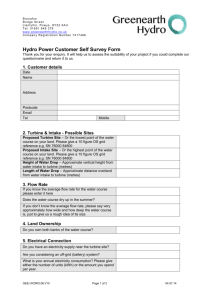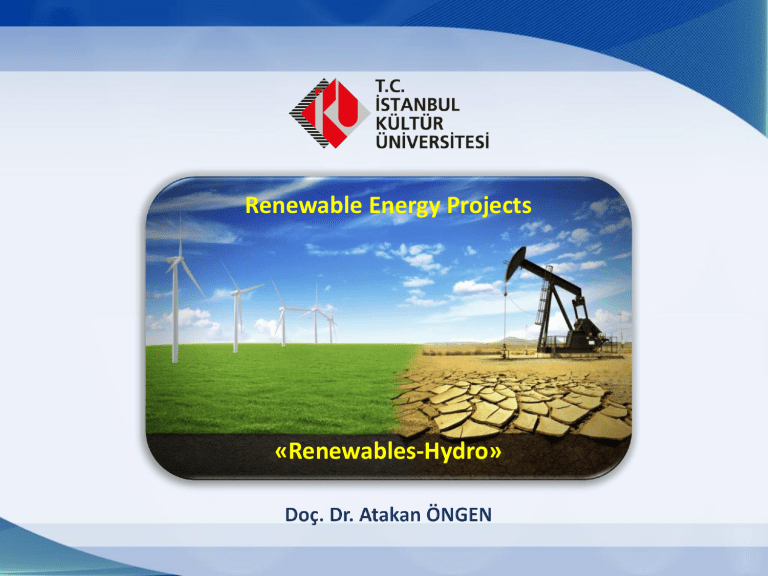
Renewable Energy Projects «Renewables-Hydro» CONTENT • What is Hydro Energy(HE)? • How? • Global use of HE Hydro • This stored potential energy is released as work because the water is in motion, and the best way to put large amounts of water in motion is to let gravity do the work. • Then the most important element for the production of “Hydro Energy” is not the water itself, as within reason any liquid could be used, but “gravity” as it is gravity that makes the water move. • Then we can correctly say that hydro energy is gravity powered energy as we are generating electricity from gravity. Hydro • Rivers and streams generate currents of water because the water in them is moving downhill, even if only slightly, flowing downwards by the pull of gravity. • The water which is flowing downhill, being pulled by gravity, contains large amounts of kinetic energy that can be extracted and used by a water turbine or water wheel and even a small stream can produce enough kinetic energy to turn a wheel. Hydro • The kinetic energy produced by the moving water is converted into either mechanical energy to perform some work or directly into electrical energy by means of an electrical generator, and this then is the basic science behind Hydro Energy production. Hydrokinetic • Hydrokinetic Energy is a highly developed form of “alternative energy” that can also be classed as a “renewable energy source”, with the English word Hydro originating from the Greek word meaning “water”. • The energy from the Sun heats large masses of water such as the sea, oceans and lakes, turning it into water vapor which rises forming clouds high in the sky. • The cold air above the clouds condenses this water vapor which then falls back to Earth as rain or snow in the hills and mountains. Hydrokinetic • The energy from the Sun heats large masses of water such as the sea, oceans and lakes, turning it into water vapor which rises forming clouds high in the sky. • The cold air above the clouds condenses this water vapor which then falls back to Earth as rain or snow in the hills and mountains. • This well known cycle keeps the mountain rivers and streams supplied with plenty of water. • This cycle of evaporation and precipitation (rainfall, snow, drizzle, etc), is called the “water cycle”, and will keep on going forever as long as the sun shines, and all for free, that’s why hydro energy is a renewable energy source. • But to use this renewable energy source to generate electricity we must first use its gravitational potential energy to spin a water turbine generator. How does Hydro Energy work? • We now know that hydro energy is the process of generating electricity from water which harness the power of the rivers and currents. • The gravitational potential energy that is stored in the water above the dam wall is released as it flows downwards through large pipes to the bottom of the dam. • As the water flows down these large pipes it passes through turbine blades at the base of the dam causing the blades of the turbine to rotate which produces electricity. • Because of the great height of the water above the turbine, called the “head”, it will arrive at the turbines at a high speed and pressure which means that we can extract a great deal of energy from it generating more electricity. How does Hydro Energy work? Hydro Energy •Hydro Energy is a clean, green technology which produces no pollution. •Unfortunately, most of the lakes and rivers that could easily be exploited have already been dammed, so the future of hydro energy lies in the development of less appealing sites. •But hydro energy is more than just a clean source of electricity. When dams are built, they create large bodies of water for fish and wildlife to survive. •These reservoirs and lakes have several other advantages and uses. •For example, they provide opportunities for outdoor activities such as sailing boats, swimming, fishing, or just enjoying the surrounding outdoors as well as using the stored water from the reservoirs for drinking and to grow crops. Advantages of Hydro Energy •Hydro energy is a clean and reliable renewable energy resource. •Hydro energy is more reliable than wind, solar or wave energy. •Micro-hydro systems produce virtually no waste, greenhouse gases or CO2 emissions. •As long as the water is there in sufficient quantity, electricity can be generated constantly. •Once the dam is built, the energy is virtually free. •Water can be stored in a dam ready to cope with peaks in electrical demand simply by controlling the amount of water released. •Hydro-electric power stations can increase to full power very quickly, unlike other power stations. •Large and mega-dams have multiple uses and can create recreational lakes and areas where before there were none. Disadvantages of Hydro Energy • Damming rivers and streams may change the natural waterways, diverting water from areas that depend on it. • Damming rivers alters the spawning migration of fish and other wildlife. • Damming rivers changes the quality, quantity and even the temperature of the water that flows downstream, which can have an impact on plant life. • Finding a suitable site to build can be difficult as the impact on residents or the environment may be unacceptable. • Dams are very expensive to build. • Large dams can only be used in a limited number of places such as those with large water supplies. • The reservoirs created by large dams and mega-dams destroy (Floods) local habitats. • Over time, dams may become unstable allowing them to self-destruct which can lead to serious flooding, including loss of life and property. Can Hydro Energy meet your energy needs? • For example, a small turbine in a stream that flows at a rate of about 12 liters per second (about 200 gallons per minute) falling from a head of about 10 meters (30 feet) can generate around 1kW (1,000 watts) of electricity at any given time. • This is more than enough to meet the basic needs of the average family home. Hydroelectricity • Hydroelectricity is the generalized term used to describe electricity that has been generated using water, hence the term hydro. • However, when we see the term “hydroelectricity” we tend to think of electricity generated by the massive hydroelectric power stations, dams and reservoirs high up in the mountains. • These huge vertical concrete walls (up to 200m in height) hold the potential energy contained within a large body of water behind these tall concrete structures extracting the energy from the moving water once it has been released downhill converting this energy into mechanical energy by means of a hydro turbine. Hydroelectric power generation systems • Run-of-river Hydroelectricity which uses the kinetic energy contained within the natural flow of a river or large creek to generate electricity. • High-head Hydroelectricity the water is dammed up and stored in a reservoir behind a high concrete dam to be used when required. The production of electrical power is through the use of the gravitational force of the falling or flowing water through the hydro turbines. • Pumped Storage Hydroelectricity is another type of reservoir power generation in which two reservoirs are used to store the energy in the water. During low cost off-peak hours, reversible turbine/generator assemblies can act as both pump and turbine pump water from a lower elevation reservoir up to a high elevation reservoir for storage. Hydroelectric power generation systems • Hydroelectric is a well established technology capable of producing power 24 hours a day. • One of the major advantages of hydroelectricity and of hydroelectric power is that like the power provided by the old style waterwheels, no fossil fuels are burned to release greenhouse gases (such as carbon dioxide and sulphur dioxide) into the atmosphere, where they can produce smog and contribute to global warming and acid rain. • Also, no chemicals are used in the production of hydroelectricity that would otherwise be disposed of in the environment. Hydroelectric power generation systems • Hydroelectricity generation is also free in that the fuel it uses to generate the electricity, the water, does not have to be produced, dug up or purchased as mother nature provides it in the form of rain and snow. • Naturally money has been spent building and maintaining the dam and hydroelectric power plant. There are also secondary benefits to hydroelectric dams. • They can provide flood control for rivers protection towns and fields downstream. • Plus the large expanse of water within the reservoirs allow for recreational activities such as swimming and boating. What are the biggest hydroelectric power plants in the world? • Three Gorges, China – 22.5GW • Itaipu, Brazil & Paraguay – 14GW • Xiluodu, China – 13.86GW • Guri, Venezuela – 10.2GW • Belo Monte, Brazil – 9.39GW • Tucurui, Brazil – 8.37GW • Grand Coulee, USA – 6.8GW • Xiangjiaba, China – 6.4GW • Sayano-Shushenskaya, Russia – 6.4GW • Longtan, China – 6.3GW Atatürk Dam and Hydro-power Plant: 169 m., 2,4GW Hydropower Installed Capacity - 2018 81 GW 48,4 GW 102 GW 8,8 GW https://www.hydropower.org/maps/worldhydropowerstatistics Hydropower Installed Capacity - 2018 https://www.hydropower.org/maps/worldhydropowerstatistics Hydropower generation in Megawatt-hour per capita 0,74 MWh/person 11,12 MWh/person 1,24 MWh/person 1 MWh/person https://www.hydropower.org/maps/worldhydropowerstatistics
